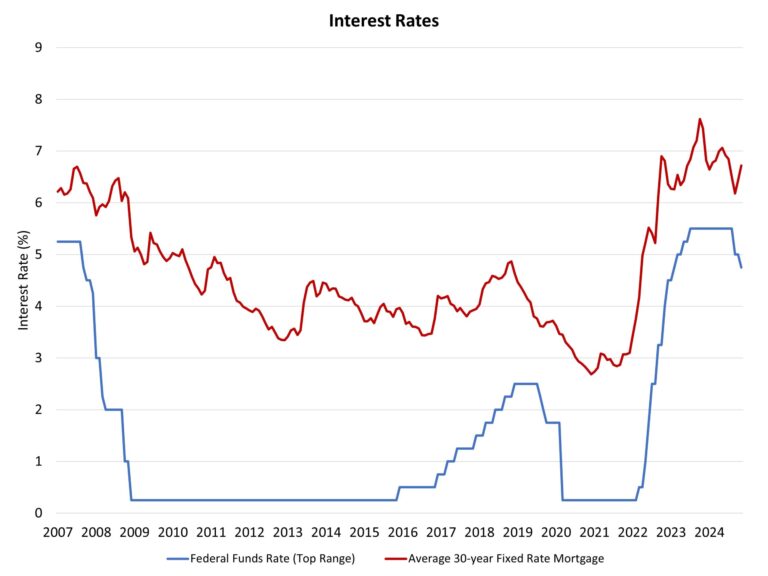The Fed cut the short-term federal funds rate by an additional 25 basis points at the conclusion of its November meeting, reducing the top target rate to 4.75%. However, while the Fed noted it is making progress to its 2% inflation target, it did not provide post-election guidance on the pace and ultimate path for future interest rate cuts. The bond market is not waiting, with the 10-year Treasury rate rising from 3.6% in mid-September to close to 4.3% due to changing growth and government deficit expectations.
Today’s statement from the Fed noted:
“Recent indicators suggest that economic activity has continued to expand at a solid pace. Since earlier in the year, labor market conditions have generally eased, and the unemployment rate has moved up but remains low. Inflation has made progress toward the Committee’s 2 percent objective but remains somewhat elevated.
The Committee seeks to achieve maximum employment and inflation at the rate of 2 percent over the longer run. The Committee judges that the risks to achieving its employment and inflation goals are roughly in balance. The economic outlook is uncertain, and the Committee is attentive to the risks to both sides of its dual mandate.”
Inflation risks for 2025 are evolving. The policy risks for the central bank had recently been between inflation (decreasing risks) and concerns regarding the health of the labor market (risks rising). However, the 2024 election result changes this outlook somewhat. In particular, the election increases the probability of additional economic growth, a tighter labor market, larger government deficits, and higher tariffs. All of these factors can be inflationary, even if they yield other macroeconomic benefits.
Consequently, the Fed will need to recalibrate its economic and policy outlook given the large number of changes that markets have digested in just the past week alone. In particular, how far will the Fed ultimately cut into 2025 and perhaps 2026? A 3% terminal federal funds rate is unlikely. Some commentators have suggested a 4% rate would at least be a threshold of reevaluation. NAHB’s outlook is for a terminal rate of 3.25%, perhaps 3.5%. However, that decision, or destination, will be dependent on factors like tariff adoption.
Markets and analysts will receive additional information at the conclusion of the December Fed meeting, which will include an update of the central bank’s Summary of Economic Projections. Given the election discussion, is worth noting that the Fed does not try to anticipate changes to future fiscal policy. The Fed will study and model anticipated changes, but such impacts would not be formally incorporated into the Fed’s outlook until such proposals are, at the very least, fully detailed and analyzed. All market participants should be aware that rising government debt levels will push nominal long-term interest rates higher.
While the question of the future policy path matters for long-term interest rates, there is a direct benefit to current easing like today’s rate cut. For example, the November rate reduction will be felt for builder and land developer loan conditions. Interest rates for such loans should move lower by approximately 25 in the coming weeks.
A reduction for the cost of builder and developer loans is a bullish sign for housing affordability. The pace of overall inflation has remained elevated due to the growth of housing/construction costs and elevated measures of shelter inflation, which can only be tamed in the long-run by increases in housing supply. Fed Chair Powell has previously noted it will take some time for rent cost growth to slow. Given recent tight financing conditions, however, the Fed noted that while consumer spending is resilient, “…activity in the housing sector has been weak.”
All things considered, with inflation having moved lower (the September core PCE measure of inflation is at 2.7%, down from 3.7% a year ago), there is clearly policy room for future rate reductions as the Fed normalizes monetary policy. A further cut to the federal funds rate in December, to a 4.5% top rate, seems likely. After that, given expected changes for fiscal policy and fiscal policy impacts, the Fed is likely to slow its pace of rate cuts, perhaps moving to one 25 basis point cut per quarter in 2025 to the ultimate terminal rate. As noted earlier, the level of this terminal rate is likely to be reevaluated in the coming months.
Discover more from Eye On Housing
Subscribe to get the latest posts sent to your email.
This article was originally published by a eyeonhousing.org . Read the Original article here. .

